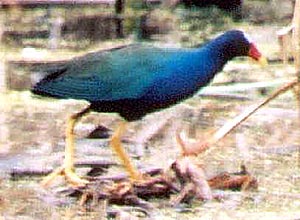Aransas NWR
Today we visited Aransas NWR, or as it could be known, "Mosquito Alley". The mosquitoes here were very bad and almost everyone suffered despite liberal use of repellent.
En route we stopped at a damp field containing long grass. In the grass were Lesser and Greater Yellowlegs, although mostly well-hidden. A Common Yellowthroat sang from the scrub at the field's edge. The real reason we stopped here was to watch a very nice White-tailed Hawk sitting on a telegraph pole. Also here we had fly-overs by six White Ibis and a Little Blue Heron.
Whilst still driving to Aransas an emergency stop added a fabulous White-tailed Kite in a tree quite close to the road and a singing Eastern Meadowlark. Also from the van we saw Brewer's Blackbird, three Northern Caracara, plus the usual Scissor-tailed Flycatchers, Great-tailed Grackles, Loggerhead Shrikes, Cattle Egrets, Brown-headed Cowbirds, TVs, BVs etc. We also had an American Crow which, we were told, was outside its normal range.
We also stopped in a small town bordering the sea. Here we had two Inca Doves, Bronzed Cowbirds, Chimney Swift and, suprisingly two pairs of Eurasian Collared-doves.
Finally at Aransas we started by chekcing a small reedy pool. This held Common Moorhen, American Coot and our first American Purple Gallinule.

American Purple Gallinule
As we walked along one of the reserve roads we saw a couple of Alligators and not much else. However, things were to get better. As we took a path which overlooked an area of open marsh Helen found a Sora in some thick reedy stuff. This bird was feeding round a large Alligator! The open marsh ares held nine Little Blue Herons (the color on these birds is fantastic - no book really shows it), a hard-to-see Common (Wilson's) Snipe, Killdeer, Least Sandpiper and two Great Blue Herons.
We then headed back to the visitor centre and the relief of air-conditioning. No sooner had we got in when we heard there was a Buff-bellied Hummingbird at the feeder. "Which feeder? Where?" Fortunately it was close by and viewable from the inside of the center. We joined the crowd watching the feeder and saw both male and female Buff-bellied Hummingbirds using it.
Leaving the visitor centre we drove to a place which overlooks open water. Using 'scopes we could see a lot of ducks on the water. After scanning and checking and discussing various birds we identified there were about 1400 Ruddy Ducks in the flock with scattered Redheads and Canvasbacks. The flock seemed to carry on around into a bay so we drove round there. Here we added lots of Lesser Scaup plus at least two, and no doubt there were more, Greater Scaup. At this second stop we also found, amongst the normal Ruddy Ducks, a leucistic bird - an almost white Ruddy Duck which looked quite peculiar amongst the normal birds. As we drove off we saw a female Javelina who came right next to the van, seemingly not bothered that we were there.
As you can imagine, birding trips are trips that involve lots of sudden stops. Another sudden stop added our first Anhinga, sitting with six Cattle Egrets beside a small pool of water. This bird was in the usual wings-held-open posture. It seemed to become aware of us and walked off wings still held open. It then flew and landed in a nearby tree.
At yet another site (Texas Birding Trail site 36) we found large pools of water with reedy edges and islands. Here were six Blue-winged Teal, one Cinnamon Teal, five Pied-billed Grebes and a female Northern Harrier. One of the group found an American Bittern hiding in the foliage. After a while it came out and showed very well. Also here we had 15 American White Pelicans flying overhead, as did Neotropic Cormorant, two White Ibis and the usual TVs.
Still eager for more birds we drove to Seadrift and along the 238 Old Seadrift Road. One stop along added at about 30 Upland Sandpipers feeding in a field. En route to the next stop we had 15 Little Blue Herons, one Great Egret, one Roseate Spoonbill, Loggerhead Shrike and Northern Caracara. The next stop, by another smallish pool of water kept us very busy. The most exciting thing about this site was the noise - there were hundreds of noisy migrating Red-winged Blackbirds in bushes and trees at the back of the pool. Amongst them were at least two fine Yellow-headed Blackbirds.
Next to the waders - five Semi-palmated Sandpipers, six Short-billed Dowitchers, four or five Lesser Yellowlegs, two Killdeer and six Black-necked Stilts. On a smaller pool behind the main one were two White Ibis and a Roseate Spoonbill.
Our final stop of the day was another field of short grass where again we found Upland Sandpipers. A few metres further on more Upland Sands were seen feeding on someone's front lawn.
This was our last day in the Rockport area. Tomorrow we head south to the Brownsville on the Rio Grande.

